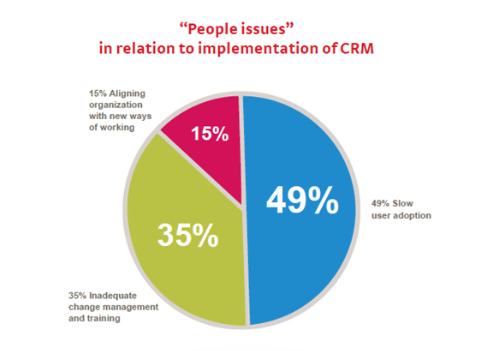It might not be them, it might be the CRM. The average salesperson has to use 10 tools to close a sale. If your CRM is adding value to the sales process, then getting salespeople to use it isn't a problem. It's when the CRM is just another chore that it becomes a drag - not only psychologically but on sales outcomes too.
There's money in good CRM use.
Money for whom? The company and the salesperson. The average ROI on CRM cost is nearly $9 for every dollar you spend. Effective CRM use increases sales and efficiency by 30%. For the salesperson, it can result in a more than 40% increase in revenue.
Sales organizations that are effective are 3X more likely to be using a CRM than teams that underperform.
And once you land a good customer, the use of the CRM across your team can create as much as a 27% boost in retention.
You can keep ringing up dollar signs if you add the lost customer potential in unconverted marketing leads. The average is about 8 out of every 10 leads that marketing brings in never close.
So why wouldn't everyone be on board with the CRM?
There are a few big reasons that salespeople don't get on board with essential CRM use. While we're not into excuses, we do think that getting a real insight into what makes a CRM actually useful is important to setting up effective sales rhythms.
Learn how the right approach can boost sales motivation with CRMs
About half the time, if you look at the most current research it is simply a result of slow user adoption. And with sales training, if it doesn't go to work right away, it simply fades away. Many sales practices are completely lost within 3 months of training.

Source: Forester Research Study of CRM Implementation
Usually, there's a disconnect in the salesperson's mind about whether the use of the CRM is for management purposes, or to actually help with sales. And if the CRM isn't integrated into the data sources, the communication tools, and the daily workflow of the salesperson, then the skepticism might be well founded.
The biggest failure points for CRMs are:
- Requirements for manual data entry. Adding manual data entry, especially duplicate data entry to the work of a salesperson adds to the 76% of their time that is already not spent selling. They know it's going to simply create greater pressure on meeting quotas.
- Data syncs that suck. There's nothing worse than having data that is incorrect or is only found in one tool. Having to look back and forth between tools is not only confusing, but it also adds a greater time burden to every step.
- Difficulty in pulling reports. Salespeople spend a lot of time pulling data together for reporting. Having to mine for that data instead of simply referencing effective reporting is a common complaint among salespeople and sales managers alike.
- Disconnected communication tools. If data in the CRM can quickly and easily be integrated into whatever communication tools are needed, it adds yet another step. Personalization from the CRM should be the norm. Notifications of opened emails, opened quotes, viewed pages and videos are a key part of being a digital salesperson who knows what is happening with the digitally networked customer.
- Lack of attribution. If you don't know where data originated or who is the owner, this may be a big flaw in your CRM.
Wonder if any of these issues are the root of the poor CRM utilization?
Salespeople may resist CRM use either if they have high expectations for the seamless way the CRM should support their work, or if they have the perception that the tools aren't going to really help them. A negative perception is a failed training or onboarding outcome.
Of course, there's always the "management by walking around" method - just start asking some salespeople about pain points with their CRM use.
And you'll have to consider the reality that some CRMs are simply not designed well or they are out-of-data. They are just clunky. Unfortunately, these CRMs don't deserve high utilization, and they make it a big lift to get strong buy-in.
Here are some ways to make it better
Automate data entry points. Ensure that you are automating the data entry points wherever possible. Use a CRM that makes this a priority.
Build around sales workflow. In the onboarding and planning phase think workflow, workflow, workflow.
Use reports well. Reports aren't just for management, they are a feedback mechanism for salespeople too. Making reports easy to access and customized for each team member is an important part of the start-up process.
Make sure training is effective. Training with sales teams requires more than just a quick orientation. Some of the early adopters will take off from that point, but some ongoing coaching will help a greater number of salespeople to adopt the CRM




